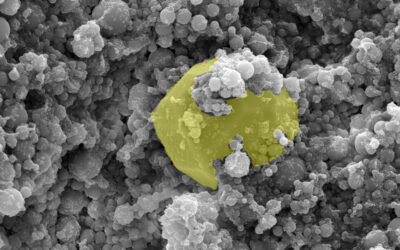Image credit: Karsten Würth on Unsplash
Rechargeable batteries are a versatile energy storage technology and are playing an increasingly important role in the transition away from fossil fuels towards renewable sources. Lithium-ion (Li-ion) batteries are a well-established technology that offers reliable and on-demand power supply for devices and vehicles of all sizes, from mobile phones to trucks and ferries. On a larger scale, stationary energy storage is becoming more and more necessary for keeping a steady power supply on electrical grids as intermittent renewable sources displace fossil-fueled power plants.
Researchers at DTU Energy in Denmark have recently published a review article on the current status of computational modeling of organic (carbon-based) battery materials. Computer simulations are widely used to predict properties of new materials, including the electro-active compounds at the heart of battery technology. Organic molecules and polymers are a more abundant, lighter, less toxic, and potentially cheaper alternative to existing inorganic battery materials that contain transition metals such as cobalt, nickel, and vanadium. Questionable mining practices and cost volatility make it particularly attractive to replace metal-based materials with their organic counterparts.
In batteries, energy is stored and released by redox-active materials (they undergo reduction and oxidation, i.e., accepting or donating electrons). The redox materials can be part of the electrodes or dissolved in the electrolyte in conventional encapsulated batteries. In a Li-ion battery, the lithium cations Li+ move back and forth between two electrodes made of intercalation materials, typically graphite and a transition metal oxide. A good electrode material must, therefore, be able to reversibly undergo insertion of metal ions, redox reactions and, at the same time, efficiently transport electrons. Replacing the currently employed electrode materials based on transition metal oxides with polymers or molecular crystals is an attractive prospect. Computer simulations can support experimental research in the challenging task of finding materials that have both the required performance and stability.
Alongside encapsulated batteries, redox flow batteries (RFBs) can offer potentially cheaper and less resource-intensive stationary energy storage, albeit with lower energy density. In RFBs, the active materials are dissolved in a liquid (water or organic solvents) stored in external tanks and circulated by pumps through the electrochemical cell where the electron exchange occurs. Therefore, one advantage is that the power and capacity can be independently scaled since they depend on the size of the cell and the tanks, respectively.
RFBs are still a niche product today and the ones commercially available are all based on inorganic redox compounds: vanadium, zinc bromide, and iron chloride. Making an organic RFB could be a real breakthrough in terms of safety and the levelized cost of storage. Finding the right molecules for this is one of the goals of two international research projects at DTU Energy. We are part of the ORBATS project, which aims to build a working organic aqueous RFB prototype, and SONAR, whose goal is to develop a multiscale computational modeling toolkit for organic RFBs.
Regardless of the specific technology, the main contributors to the cost of batteries are the redox-active materials. Organic molecules and polymers are becoming more and more attractive for batteries, mainly because of their potentially lower cost. Compared to metal ions, organic materials also tend to have faster redox reactions and can, therefore, enable higher power densities. The tunability of properties through chemical synthesis and modification is also a significant advantage. However, the vast number of molecules that are possible to synthesize makes it very challenging to find those with the right combination of properties for a specific application.
This is where computational chemistry can help in many ways. High-level quantum chemistry calculations for specific compounds can help understand experimental observations and predict the effects of substitutions and modifications. Less costly calculations can be performed on larger numbers of known and unknown chemical structures, an approach called high-throughput screening. Such approaches can be made even more efficient with machine learning methods and can lead to a better understanding of structure-property relationships and the discovery of new or previously unexplored classes of materials.
The maximum voltage of a battery ultimately depends on the redox potentials of its active materials. To compute potentials accurately, it is necessary to accurately model solvation, i.e., how the energies of the compounds in their relevant redox states are affected by the environment’s presence, be it solvent in RFBs or the bulk material in solid electrodes. Although many theoretical methods have been developed to describe solvation effects, the authors think there is still room for improvement, especially for negatively charged molecules in water. Other areas where the authors expect significant progress to be made are the prediction of solubility, automated search for possible degradation reactions, and the development of multiscale modeling frameworks.
Written by: Rocco Peter Fornari and Piotr de Silva, Technical University of Denmark
Reference: Rocco Peter Fornari, Piotr de Silva ‘Molecular modelling of organic redox-active battery materials’ WIREs Computational Molecular Science (2020). DOI: 10.1002/wcms.1495

















